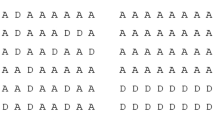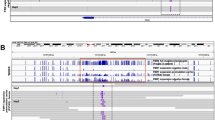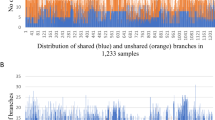Abstract
Yin yang haplotype pairs differ at every SNP. They would not be accounted for by population models that incorporate sequential mutation, with or without recombination. Previous reports have claimed that there is a tendency for common SNPs to form yin yang haplotypes more often than would be expected by sequential mutation or by a random sample of all possible haplotypic arrangements of alleles. In the course of analysing next-generation sequencing data, instances of yin yang haplotypes being formed by very rare variants within a single gene were observed. As an example, this report describes a completely yin yang haplotype formed by eight rare missense variants in the ABCA13 gene. Of 1000 genome subjects, 21 have a copy of the alternate allele at all eight of these positions and a single subject is homozygous for all of them. None of the other 1070 subjects possesses any of the altetrnates. Thus, the eight alternate alleles are always found together and never occur separately. The existence of such yin yang haplotypes has important implications for statistical methods for analysing rare variants. Also, they may be of use for gaining a better understanding of the history of human populations.
Similar content being viewed by others
Log in or create a free account to read this content
Gain free access to this article, as well as selected content from this journal and more on nature.com
or
References
Zhang J, Rowe WL, Clark AG, Buetow KH : Genomewide distribution of high-frequency, completely mismatching SNP haplotype pairs observed to be common across human populations. Am J Hum Genet 2003; 73: 1073–1081.
Curtis D, Vine AE, Knight J : Study of regions of extended homozygosity provides a powerful method to explore haplotype structure of human populations. Ann Hum Genet 2008; 72: 261–278.
Curtis D, Vine AE : Yin yang haplotypes revisited - long, disparate haplotypes observed in European populations in regions of increased homozygosity. Hum Hered 2010; 69: 184–192.
Curtis D : Approaches to the detection of recessive effects using next generation sequencing data from outbred populations. Adv Appl Bioinform Chem 2013; 6: 29–35.
Abecasis GR, Auton A, Brooks LD et al: An integrated map of genetic variation from 1092 human genomes. Nature 2012; 491: 56–65.
He Z, O'Roak BJ, Smith JD et al: Rare-variant extensions of the transmission disequilibrium test: application to autism exome sequence data. Am J Hum Genet 2014; 94: 33–46.
Author information
Authors and Affiliations
Corresponding author
Ethics declarations
Competing interests
The author declares no conflict of interest.
Rights and permissions
About this article
Cite this article
Curtis, D. Rare missense variants within a single gene form yin yang haplotypes. Eur J Hum Genet 24, 139–141 (2016). https://doi.org/10.1038/ejhg.2015.74
Received:
Revised:
Accepted:
Published:
Issue date:
DOI: https://doi.org/10.1038/ejhg.2015.74
This article is cited by
-
The human genome harbours widespread exclusive yin yang haplotypes
European Journal of Human Genetics (2024)
-
Quinoa genome assembly employing genomic variation for guided scaffolding
Theoretical and Applied Genetics (2021)
-
Intricacies in arrangement of SNP haplotypes suggest “Great Admixture” that created modern humans
BMC Genomics (2017)



